
Last year I was fortunate enough to visit Shanghai, and naturally indulged in some film-related activities while I was there. Checking out the beautiful Art Deco cinemas that still exist in the city was a high priority, as was making a trip to the Shanghai Film Museum (上海电影博物馆). Shanghai has always been the centre of the Chinese film industry, and the Museum celebrates that heritage. Here, I’ll share my thoughts—and many photos!—with you. Come on a tour with me!

Outside the entrance to the Museum
The Museum, which is located in a revamped old studio in Shanghai’s film district, opened in 2013. From outside, it looks part warehouse, part office-building, but the interior is impressive right off the bat. A huge screen in the style of a 35mm film frame greets the museum-goer, switching between a series of images and logo/title-type images that introduce the Museum.

Seriously big.
If one looks up, there are sculptures of a whole range of film equipment—and, for some reason, a jeep—suspended from the high ceiling. (Edit: this jeep, a real vehicle, was used in filming 南征北战 | From Victory to Victory (1952), a Communist film about the Chinese civil war).

Projectors, musical instruments, lights with barn-doors, film reels … and an all-terrain vehicle.
At the ticket desk, a wall text gives an overview of Shanghainese cinema, asserting its contribution to Chinese culture, and continued status as the main film city of the Middle Kingdom. However, the museum proper begins when one ascends to the fourth floor, named Memories in Light and Shadow. One enters through the Walk of Fame, in which “visitors will bathed in the limelight and feel the same glow and glory that belong to a star”. This is an accurate description: the dynamically lit floor and paparazzi simulation is spectacular indeed:

It’s visually very cool, and an engaging way to have people enter the Museum exhibit. Needless to say, I spent my share of time in there clowning and striking a pose.

Past the Walk of Fame, one enters the Galaxy of Stars, a huge, dazzling display devoted to key figures in Chinese film history, depicted in a huge grid of individual portraits. Like the Walk of Fame, this is so glittery as to be overwhelming: the level of the illumination of each images varies, giving an impression of constant movement which is only intensified by the polished ceiling and floor. Here’s a view of one side of this Galaxy:
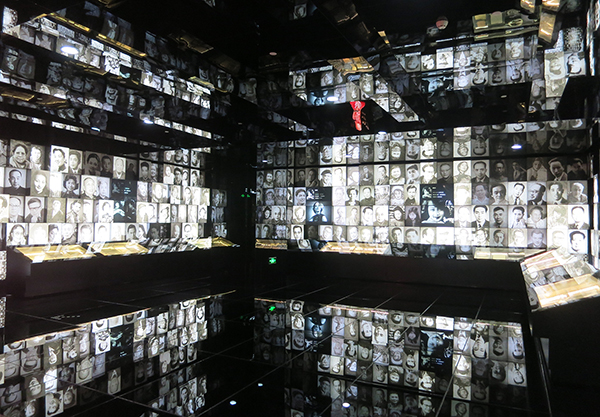
It was a lot of fun to pick out different actors and directors. For example, here we have Gong Li rubbing shoulders with Jackie Chan, Zhang Ziyi, Jiang Wen, and (at right), Ruan Lingyu.


The lighting conditions weren’t favourable for getting photos with me in them, so you’ll just have to imagine me hanging out with Li Lili (centre).

And another long shot, this time starring me!
The display cases around the sides held interesting filmic artefacts: scripts, cameras, the microphone used for recording a specific film, etc. Another key feature was the touch-screen computers which had ‘Facebook’ on them, that is, a biographical index of Chinese film personnel. Silent-era stars were well-represented: there were entries for Ruan Lingyu, Wang Renmei, Jin Yan, Li Lili, Hu Die, etc. A quick gallery for those interested (click to embiggen):
The next section—still on the same floor—is the Achievements of Masters section. This exhibit highlights fourteen masters of Shanghai cinema, and showcases props, artwork, photos, and ephemera relating to their work. The material was interesting, varied, and arranged well, but there was one problem with the presentation … the exhibits all feature different lighting setups and screens, and there is also an abundance of transparent display cases and partitions—which means reflections, reflections everywhere.

Looking at the above picture, can you make sense of this exhibit devoted to Cai Chusheng (whose film New Women I wrote about here), and read the explanatory text? A closer view:

Still quite difficult, no? Because of the lighting and reflectance, it wasn’t actually possible to stand in one place and take in what the display was saying—one had to move around to get decent light angles on each word. This is the kind of user-experience design feature that may seem minor, but that actually really impacts the way museum-goers can access the exhibits.
Also on Floor Four was an exhibit dedicated to the Nanjing Road, including beautiful dioramas of an early film shoots taken there, a replication of an alcove at Café Federal, an elegant café frequented by Eileen Chang in Shanghai’s glamour days, and an interactive digital ‘jigsaw puzzle’ of locations, aimed at children.

Envisaging an early film set.
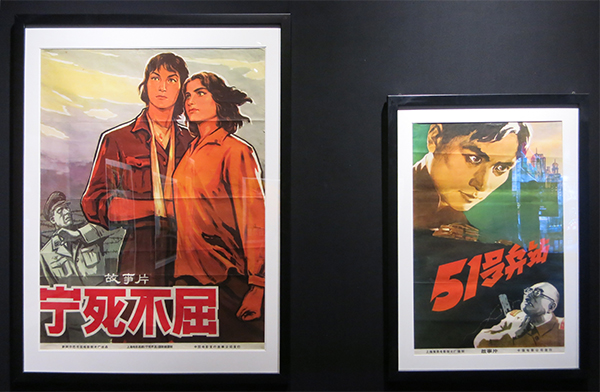
These two posters are for Albanian film Horizonte të hapura | Clear Horizons (1969), here called 宁死不屈 | Rather Die Than Surrender; and Chinese film 51 号兵站 | Military Outpost 51 (1961).
Another fun section was A Century’s History of Film Distribution and Exhibition, which includes a range of posters, like those of the propaganda films shown in the image above; mini-replicas of early film screening venues, including one of China’s first professional film theatre, the Hongkew Cinema; displays on Hu Die and Ruan Lingyu, two of the great actresses of art deco Shanghai; and adverts for Hollywood films of the 1930s.

Statue of Hu Die (standing) and Ruan Lingyu. The two women were close friends.
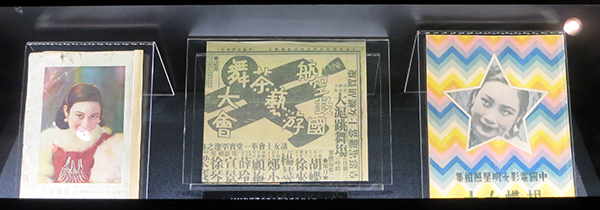
Display case devoted to Hu Die, the most popular actress of her era, who was crowned China’s ‘Movie Queen’ in 1933.

And the same for Ruan Lingyu. The booklet at right is the 1936 special edition of Lianhua Pictorial commemorating the one-year anniversary of Ruan’s death. I think that it is the same as this magazine (PDF), which has a slightly different cover.

Barbara Stanwyck in Gambling Lady (1934)

Garbo in Queen Christina (1933)
There are also interesting pieces of ephemera, such as Zheng Junli’s membership card for the China Filmmaking Association—and the matryoshka dolls given to him in 1957 by Zhou Enlai!
Down to Floor Three, The Long History of Cinema. A subsection of this floor, Dream Factories, is devoted to the major film studios of Shanghai: Lianhua, Mingxing, and Tianying.

Here I am in front of the Lianhua display.
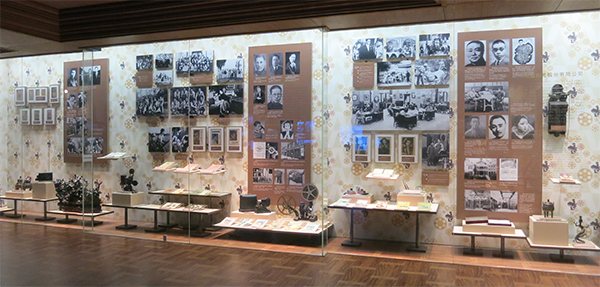
Wide view.
As much as I’d loved the exhibits to date, this part was what I’d been waiting for. Studio magazines! A 16mm camera used by early Chinese filmmakers! The book that Hu Die published about her trip to America! Of course, I would have loved tons more material, but this was pretty solid for a public museum.

Though again, not an easy-reading experience.
There were also lightbox-wall displays devoted to Ruan Lingyu’s 神女 | The Goddess (dir. Wu Yonggang), and 大路 | The Big Road (dir. Sun Yu), both 1934; as well as information on ongoing production in the 1930s, and the output of studios such as Yihua.
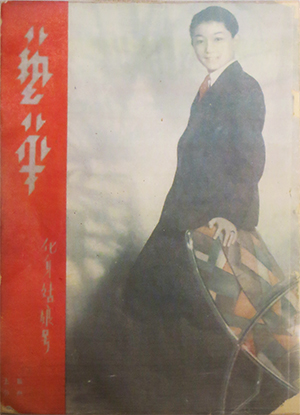
Yihua publication devoted to their film 化身姑娘 | Tomboy (1936). This gender-bending “soft film” is one that I’d love to see.
Perhaps my favourite part of the entire museum was the next section: The Flowing River of Light and Shadow, dedicated to film technology. I am in the preservation field and work with film in my job, so I just adore seeing this kind of thing. As elsewhere in the Museum, the subtext of “Shanghai = innovative and supreme” is incredibly unsubtle, but these presentations were beautifully done. To wit:

There are reel-to-reel tape recorders, different types of studio and projector lights, a Steenbeck editing bench, sound mixing consoles, a 35mm colour analyzer (used for grading or colour-timing film), other lab equipment such as printers and processors … and film cans galore.

A Chinese-made gang synchronizer with viewer; tape splicer in foreground.

More cameras! Those are film cases stacked up behind.
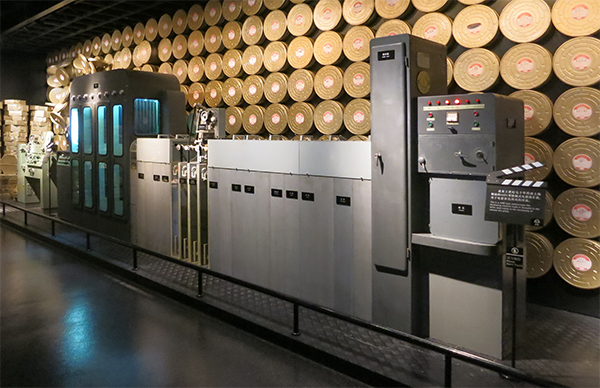
A Shanghai-made colour film processing machine.
Regarding film processing, the introductory text to this section states that “the length of all the film copies developed and printed by the Shanghai Film Technology Studio totals 1.1 billion metres, which could circle the Earth approximately 27.5 times.”
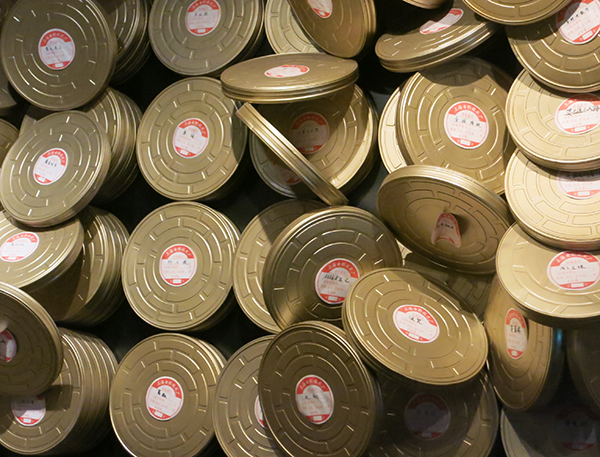
It’s no wonder they have so many film cans.
In the twilight time of photochemical film, I think many people have a fascination with analogue film and its technology; if so, they will find this part of the museum a treat. Here’s a sweep of the floor:
https://gfycat.com/RectangularWeeklyGreendarnerdragonfly
Dig that shakey cam …
Downwards to Floor Two, which has the theme Film Workshops. At this point I was both low on camera battery and somewhat energy-depleted myself, so I don’t have a lot of photos from this floor. Essentially, this part of the museum presents a series of film studio spaces: soundstage, post-production studio, animation workshop, foley recording booth, make-up and costume department, etc. I really liked both the concept and the execution of this ‘behind the scenes’ look at film production. In fact, some of these studios are actually professional working spaces.
At the time I visited, the exhibit on animation was dedicated to the film Uproar in Heaven (1964), a landmark in Chinese animation and one of the many, many adaptations of the Monkey King myth (i.e., Journey to the West). The art style is just lovely; unfortunately, it was the last major animated film of its era that was made before the Cultural Revolution caused the shutdown of the film industry. A new restoration was undertaken in 2012, which took a free hand in reinterpreting the film and resulted in a new 3D release.

Uproar in Heaven celebrates its fiftieth anniversary.
This floor also featured some kid-oriented examples of pre-cinematic moving image devices: the zogroscope, kinetoscope, etc. Always nice to see these kind of items!

Back on the ground floor: the wall display A Century’s Splendour. To the left of the studio light is a shot of Ruan Lingyu in 神女 | The Goddess (1934).
Then back down to the entrance floor. As I indicated at the start of this post, it’s essentially a large atrium with various displays scattered round, as well as the ticket desk, giftshop, and café. One of the big features is a wall display, The Many Firsts, which lists thirty milestones and achievements that Shanghai has achieved for the Chinese film industry, accomplished “with pioneering spirit, wisdom and hard work”. I’m going to quote all of the silent-era ‘firsts’ (texts lightly edited), partly because I imagine that many people aren’t too familiar with early Chinese film history and it’s interesting, but also because I think this display is emblematic of the museum’s overall approach.
- 1896. The FIRST city to show a “shadow play” in China: On June 30th of 1896, “Another Village” (a teahouse) in the Xu Garden showed “a western shadow play” during the interval of vaudeville shows.
- 1897. The FIRST city to screen a film: On May 22nd of 1897, the first recorded film screening in Chinese history took place at the Astor House (today’s Pujiang Hotel) along the Huangpu River.
- 1897. The FIRST film review: The earliest film review found till this day is entitled “The Miracle of Shadow Plays”, which was published on June6, 1897 in Sin Wan Pao, a modern newspaper created during the reign of Qing Emperor Guangxu.
- 1908. The FIRST professional cinema: On December 22nd of 1908, Antonio Ramos from Spain rented a skating rink at the intersection of the Haining Road and the Zhapu Road, on which he built a simple house made of iron with 250 seats. This house was named Hongkew Cinema, the earliest venue designed solely for film screenings in China.

- 1909. The FIRST production company: in 1909, American businessman Benjamin Polaski established the Asia Film Company in Shanghai, which became the earliest film production company in China. It made a few short documentaries, including Empress Dowager Ci Xi and Unfortunate Children.
- 1913. The FIRST short fictional film: The Difficult Couple [难夫难妻], produced in 1913 by the Asia Film Company (written by Zheng Zhengqiu, co-directed by Zhang Shichuan and Zheng Zhengqiu), is the earliest fictional film made by the Chinese.
- 1921. The FIRST film publication: China’s first professional film publication Motion Picture Gazetteer was launched in Shanghai in February 1921.
- 1921. The FIRST full-length feature film: In 1921, the China Motion Picture Research Society produced Yan Ruisheng [阎瑞生] (10 reels).
- 1922. The FIRST film school: Mingxing (Star) Film Studio’s affiliated Mingxing Shadowplay School was founded in 1922 with Zheng Zhengqiu as the school principal.
- 1925. The FIRST published screenplay: In 1925, Shanghai’s Eastern Miscellany (Vol. 22, No. 1-4) began to publish the screenplay of Madame Shentu [申屠氏] written by Hong Shen.
- 1926. The FIRST united distribution company: in 1926, five production companies, namely Mingxing (Star), Shanghai (Shanghai Photoplay Co.), Shenzhou (Cathay Film Corp.), Da Zhonghua Baihe (Great China Lilium Pictures), and Minxin (China Sun Motion Picture Co.), jointly founded Liuhe Yingxi (United Film Exchange).
- 1926. The FIRST Movie Queen: In 1926, a film expo was held in the New World Pleasure Ground of Shanghai, at which a fan poll was conducted to select the “most popular female star” in China. The the popular actress Zhang Zhiyun [张织云] was crowned the “Movie Queen” title.

Zhang Zhiyun in The Sex Trap (1927). from The Chinese Mirror
- 1930. The FIRST film song: The film Wild Flowers [野草闲花] produced by Lianhua (United Photoplay Service Company) in 1930 for the first time used sound-on-disk technology for its theme song named Seeking Brother’s Words sung by Jin Yan and Ruan Lingyu.
- 1931. The FIRST Chinese sound film: In 1931, the Mingxing Film Studio and Pathé-Orient, relying on sound-on-disk technology, successfully produced China’s first sound film Singsong Girl Red Peony [歌女红牡丹].
- 1932. The FIRST Movie King: In 1932, organized by the Movietone, a contest for the title of “Movie King” was held in Shanghai. Jin Yan [金焰] from Lianhua was crowned the “Movie King”.
- 1933. The FIRST left-wing film: Mingxing’s 1933 narrative film Wild Torrent [狂流], written by Xia Yan and directed by Cheng Bugao, was deemed by the media “an epoch-making film made by Mingxing”. It was also identified as China’s first left-wing film.
- 1935. The FIRST international film award: At the 1935 Moscow International Film Festival held in the former Soviet Union, Lianhua’s Song of the Fishermen [渔光曲], directed by Cai Chusheng, won an honourable prize, the first international award won by any Chinese film.
The ground floor also features a replica of the set of 乌鸦与麻雀 | Crows and Sparrows (dir. Zheng Junli, 1949); there’s also a display devoted to the Chinese National Anthem “March of the Volunteers”, which was originally the theme song to the 1935 film 风云儿女 | Children of Troubled Times.
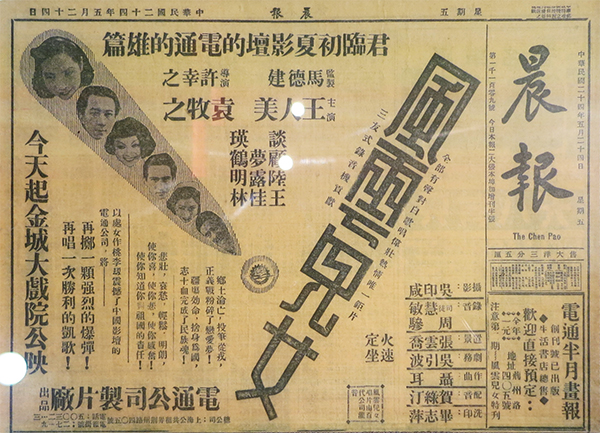
Newspaper ad for Children of Troubled Times; Wang Renmei at top left, Yuan Muzhi next down.

Metal film cans for Children of Troubled Times, housed at the China Film Archive.
And one of the coolest artefacts of all: the original Newall camera owned by Lianhua that was used to shoot a number of their biggest films, such as 神女 | The Goddess (1934), 大路 | The Big Road (1934), and 联华交响曲 | Lianhua Symphony (1937).

So, what does it all add up to? In terms of the numbers, this webpage on the design of the Museum gives some stats: it has an area of 15,000 square metres, and includes over 3,000 exhibits (i.e., exhibited items), and over 70 interactive installations. (The page has a lot of photos, taken with a far better camera + lens than mine, so you may like to have a look).
Firstly, I have to say that it is a very impressive and enjoyable museum. Obviously no expense was spared in its creation, and it shows—there are a lot of interactive displays, media galore, models, artefacts, paper matter and photographs, all in service of a strong evocation of rich tradition and history as well as the living present. A broad range of subjects is covered: stardom, technology, production and post-production, animation, advertising, etc. I didn’t like every aspect of the design—as described above, the Achievements of Masters exhibit was a bit visually cluttered and overwhelming—but most displays were done with elegance. The River of Dreams section on film technology in particular made the most of the space.
But for a film museum filled with many screens, there were fewer film clips that one would expect. There’s a certain tension between the temporal nature of cinema versus the spatial nature of a museum, and it seems the designers erred on the side of the latter: more opportunity to view the stars and actors in action would have been very welcome. I also admit to being disappointed by the quality of the silent-era films on view—I’d assumed this would be my chance to finally see clips of these movies in high quality, but it was not so. You’d think the museum would be able to get HD transfers from the China Film Archive. Also, more stills relating to silent-era film-making were familiar to me than I expected, although I’m aware of my state of geekery in this domain.
What of the message of the museum? In recent times, museums have received a lot of attention from scholars. To briefly summarize, they are now understood as active producers of knowledge and canon formation—rather than simply showcasing objects of the past for their audiences, museums are actively interpreting the past and creating new historical narratives. Much ink has been spilt about the ways in which museums reflect, translate, or create ideology, so I won’t get too deep into that here; suffice it to say that the contribution of museums to national identity is a hot topic of analysis.
The Shanghai Film Museum is a good example of this. It has a very clear and predictable agenda: to promote Shanghai as the most important place for Chinese film, both historically and in the present; and to assert the importance of film in shaping a unified, modern Chinese identity. The introductory wall text to the museum is direct: straight away, the visitor is told that Shanghainese cinema has “[contributed] to the construction of a shared dream of the Chinese nation-state and [enriched] the collective memory of the Chinese people living in the three places across the Taiwan strait and overseas”. (A none-too-subtle dig at Taiwan and Hong Kong there).
Obviously, in such a museum, it’s par for the course that the undeniably numerous achievements of the Shanghai film industry will be foregrounded (e.g., the wall of The Many Firsts). A lot of facts are presented and the tone isn’t generally too over-the-top, even if there are some wall texts that end with mentions of the “dynamic and market-oriented” film system of the Shanghai Film Group, creator of the museum.

Poster for 最后八个人 | The Last Eight (1980).
That said, the displays and texts left out something which was striking in its absence: the wider historical context of the material presented. Major events in China’s tumultuous 20th century are all but glossed over: if you’re looking for an exploration of film in relation to the Second Sino-Japanese War, the occupation of Shanghai, or the Cultural Revolution, you won’t find much here. These events aren’t completely ignored—for example, a photo that was censored during the Cultural Revolution is on display—but they are definitely downplayed. Quite a few film personnel from Chinese film’s first Golden Age aligned themselves with the Nationalists (Kuomintang) and suffered for it later, but you wouldn’t know that from their ‘Facebook’ biographies. No Chinese museum is going to present a balanced account of these events, but a little more background information would have been welcome, and an exhibit on the use of film as propaganda would have been very interesting.
All in all, the Shanghai Film Museum is a fascinating and dynamic experience. If anyone else has visited, I’d love to hear what you thought! And if not, I hope you’ve enjoyed this overview. As the Film Museum says:
Time flies like an arrow, but the world still needs cinema. The wheel of time could easily age a person, but after more than a century, cinema still remains young.
– – –
The Shanghai Film Museum is located at 595 North Caoxi Road, Xuhui. The nearest metro station is Shanghai Indoor Stadium (aka Shanghai Gymnasium; 上海体育馆站) on lines 1 and 4.
Please note: Except where marked otherwise, all photos here posted are my own and are not to be reposted without permission.







Thank you for the fascinating tour. I visited China once (in 1986) but never even got to Shanghai. Chances are, I’ll never see this location in person, but seeing it through the eyes of a fellow film-history-geek counts for a lot. I had no idea you worked in film preservation! I suppose I shouldn’t be surprised, seems like a lot of us are in some kind of preservation/curation/access-related career. I really appreciated your thoughts and images.
LikeLike
Thanks for the comment, Pope. Yes, AV preservation is my thing :) Perhaps I’ve mentioned it here and there, not sure.
It’s definitely a treat if you do make it to Shanghai someday!
LikeLiked by 1 person
Nice post! You’re a lot shorter than I imagined though! ;-) :-P
LikeLike
I’m not actually a short person! The displays are all huge.
LikeLike
Hehe. I know, I was just kidding. ;-)
LikeLiked by 1 person
This is wonderful. I will probably never get the chance to go there, but your tour helps a TON! Thank you — again — for the wonderful post. My brother is an Asian film fanatic. I am sharing this with him.
LikeLike
Thank you AS, happy to hear that you enjoyed the virtual tour!
LikeLike
My last visit to Shanghai was 10 years ago and time flies so fast… I definitely love how you introduced Li Lili, who I believe tends to be overlooked compared to the great Ruan Lingyu;)
LikeLike
You are in Japan, no? And yes, I enjoy Li Lili’s humour and energy just as I appreciate Ruan’s deep emotion. :-)
LikeLike